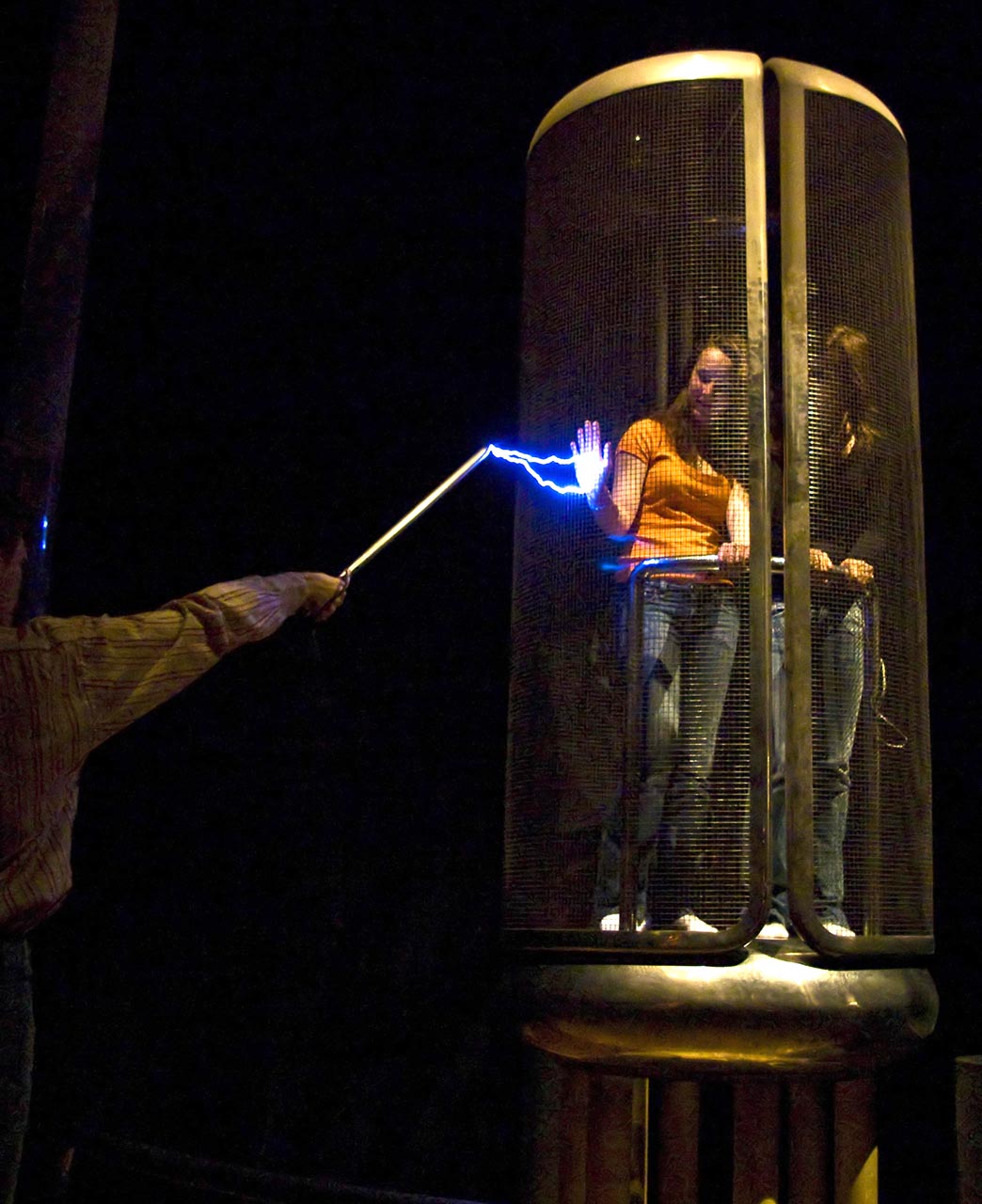|
Everhart–Thornley Detector
The Everhart–Thornley detector (E–T detector or ET detector) is a secondary electron and back-scattered electron detector used in scanning electron microscopes (SEMs). It is named after its designers, Thomas E. Everhart and Richard F. M. Thornley, who in 1960 published their design to increase the efficiency of existing secondary electron detectors by adding a light pipe to carry the photon signal from the scintillator inside the evacuated specimen chamber of the SEM to the photomultiplier outside the chamber. Prior to this Everhart had improved a design for a secondary electron detection by Vladimir Zworykin and Jan A. Rajchman by changing the electron multiplier to a photomultiplier. The Everhart–Thornley Detector with its lightguide and highly efficient photomultiplier is the most frequently used detector in SEMs. The detector consists primarily of a scintillator inside a Faraday cage inside the specimen chamber of the microscope. A low positive voltage Vol ... [...More Info...] [...Related Items...] OR: [Wikipedia] [Google] [Baidu] |
Secondary Electrons
Secondary electrons are electrons generated as ionization products. They are called 'secondary' because they are generated by other radiation In physics, radiation is the emission or transmission of energy in the form of waves or particles through space or a material medium. This includes: * ''electromagnetic radiation'' consisting of photons, such as radio waves, microwaves, infr ... (the ''primary'' radiation). This radiation can be in the form of ions, electrons, or photons with sufficiently high energy, i.e. exceeding the ionization potential. Photoelectrons can be considered an example of secondary electrons where the primary radiation are photons; in some discussions photoelectrons with higher energy (>50 eV) are still considered "primary" while the electrons freed by the photoelectrons are "secondary". Applications Secondary electrons are also the main means of viewing images in the scanning electron microscope (SEM). The range of secondary electrons de ... [...More Info...] [...Related Items...] OR: [Wikipedia] [Google] [Baidu] |
Backscatter
In physics, backscatter (or backscattering) is the reflection of waves, particles, or signals back to the direction from which they came. It is usually a diffuse reflection due to scattering, as opposed to specular reflection as from a mirror, although specular backscattering can occur at normal incidence with a surface. Backscattering has important applications in astronomy, photography, and medical ultrasonography. The opposite effect is forward scatter, e.g. when a translucent material like a cloud diffuses sunlight, giving soft light. Backscatter of waves in physical space Backscattering can occur in quite different physical situations, where the incoming waves or particles are deflected from their original direction by different mechanisms: *Diffuse reflection from large particles and Mie scattering, causing alpenglow and gegenschein, and showing up in weather radar; *Inelastic collisions between electromagnetic waves and the transmitting medium ( Brillouin scattering ... [...More Info...] [...Related Items...] OR: [Wikipedia] [Google] [Baidu] |
Sensor
A sensor is often defined as a device that receives and responds to a signal or stimulus. The stimulus is the quantity, property, or condition that is sensed and converted into electrical signal. In the broadest definition, a sensor is a device, module, machine, or subsystem that detects events or changes in its environment and sends the information to other electronics, frequently a computer processor. Sensors are used in everyday objects such as touch-sensitive elevator buttons ( tactile sensor) and lamps which dim or brighten by touching the base, and in innumerable applications of which most people are never aware. With advances in micromachinery and easy-to-use microcontroller platforms, the uses of sensors have expanded beyond the traditional fields of temperature, pressure and flow measurement, for example into MARG sensors. Analog sensors such as potentiometers and force-sensing resistors are still widely used. Their applications include manufacturing and machinery ... [...More Info...] [...Related Items...] OR: [Wikipedia] [Google] [Baidu] |
Scanning Electron Microscope
A scanning electron microscope (SEM) is a type of electron microscope that produces images of a sample by scanning the surface with a focused beam of electrons. The electrons interact with atoms in the sample, producing various signals that contain information about the surface topography and composition. The electron beam is scanned in a raster scan pattern, and the position of the beam is combined with the intensity of the detected signal to produce an image. In the most common SEM mode, secondary electrons emitted by atoms excited by the electron beam are detected using a secondary electron detector ( Everhart–Thornley detector). The number of secondary electrons that can be detected, and thus the signal intensity, depends, among other things, on specimen topography. Some SEMs can achieve resolutions better than 1 nanometer. Specimens are observed in high vacuum in a conventional SEM, or in low vacuum or wet conditions in a variable pressure or environmental SEM, an ... [...More Info...] [...Related Items...] OR: [Wikipedia] [Google] [Baidu] |
Thomas Eugene Everhart
Thomas Eugene Everhart FREng (born February 15, 1932, in Kansas City, Missouri) is an American university president, educator, and physicist. His area of expertise is the physics of electron beams. Together with Richard F. M. Thornley he designed the Everhart–Thornley detector. These detectors are still in use in scanning electron microscopes, even though the first such detector was made available as early as 1956. Everhart was elected a member of the National Academy of Engineering in 1978 for contributions to the electron optics of the scanning electron microscope and to its use in electronics and biology. He was appointed an International Fellow of the Royal Academy of Engineering in 1990. He served as chancellor of the University of Illinois at Urbana-Champaign from 1984 to 1987 and as the president of the California Institute of Technology from 1987 to 1997. Early life and education Everhart's parents were William E. Everhart and Elizabeth A. West. Everhart received hi ... [...More Info...] [...Related Items...] OR: [Wikipedia] [Google] [Baidu] |
Richard F
Richard is a male given name. It originates, via Old French, from compound of the words descending from Proto-Germanic language">Proto-Germanic ''*rīk-'' 'ruler, leader, king' and ''*hardu-'' 'strong, brave, hardy', and it therefore means 'strong in rule'. Nicknames include " Richie", " Dick", " Dickon", " Dickie", " Rich", " Rick", "Rico (name), Rico", " Ricky", and more. Richard is a common English (the name was introduced into England by the Normans), German and French male name. It's also used in many more languages, particularly Germanic, such as Norwegian, Danish, Swedish, Icelandic, and Dutch, as well as other languages including Irish, Scottish, Welsh and Finnish. Richard is cognate with variants of the name in other European languages, such as the Swedish "Rickard", the Portuguese and Spanish "Ricardo" and the Italian "Riccardo" (see comprehensive variant list below). People named Richard Multiple people with the same name * Richard Andersen (other) * ... [...More Info...] [...Related Items...] OR: [Wikipedia] [Google] [Baidu] |
Photomultiplier
A photomultiplier is a device that converts incident photons into an electrical signal. Kinds of photomultiplier include: * Photomultiplier tube, a vacuum tube converting incident photons into an electric signal. Photomultiplier tubes (PMTs for short) are members of the class of vacuum tubes, and more specifically vacuum phototubes, which are extremely sensitive detectors of light in the ultraviolet, visible, and near-infrared ranges of the electromagnetic spectrum. ** Magnetic photomultiplier, developed by the Soviets in the 1930s. ** Electrostatic photomultiplier, a kind of photomultiplier tube demonstrated by Jan Rajchman of RCA Laboratories in Princeton, NJ in the late 1930s which became the standard for all future commercial photomultipliers. The first mass-produced photomultiplier, the Type 931, was of this design and is still commercially produced today. * Silicon photomultiplier, a solid-state device converting incident photons into an electric signal. Silicon photomul ... [...More Info...] [...Related Items...] OR: [Wikipedia] [Google] [Baidu] |
Vladimir Zworykin
Vladimir Kosma Zworykin (1888/1889July 29, 1982) was a Russian-American inventor, engineer, and pioneer of television technology. Zworykin invented a television transmitting and receiving system employing cathode-ray tubes. He played a role in the practical development of television from the early thirties, including charge storage-type tubes, infrared image tubes and the electron microscope. Early life and education Vladimir Zworykin was born in Murom, Russia, in 1888 or 1889, to the family of a prosperous merchant, merchants. He had a relatively calm upbringing, and he rarely saw his father except on religious holidays. He studied at the St. Petersburg Institute of Technology, under Boris Rosing. He helped Rosing with experimental work on television in the basement of Rosing's private lab at the School of Artillery of Saint Petersburg. They worked on the problem of "electrical telescopy," something Zworykin had never heard of before. At this time, electrical telescopy (or te ... [...More Info...] [...Related Items...] OR: [Wikipedia] [Google] [Baidu] |
Jan A
Jan, JaN or JAN may refer to: Acronyms * Jackson, Mississippi (Amtrak station), US, Amtrak station code JAN * Jackson-Evers International Airport, Mississippi, US, IATA code * Jabhat al-Nusra (JaN), a Syrian militant group * Japanese Article Number, a barcode standard compatible with EAN * Japanese Accepted Name, a Japanese nonproprietary drug name * Job Accommodation Network, US, for people with disabilities * ''Joint Army-Navy'', US standards for electronic color codes, etc. * ''Journal of Advanced Nursing'' Personal name * Jan (name), male variant of ''John'', female shortened form of ''Janet'' and ''Janice'' * Jan (Persian name), Persian word meaning 'life', 'soul', 'dear'; also used as a name * Ran (surname), romanized from Mandarin as Jan in Wade–Giles * Ján, Slovak name Other uses * January, as an abbreviation for the first month of the year in the Gregorian calendar * Jan (cards), a term in some card games when a player loses without taking any tricks or scoring a m ... [...More Info...] [...Related Items...] OR: [Wikipedia] [Google] [Baidu] |
Scintillator
A scintillator ( ) is a material that exhibits scintillation, the property of luminescence, when excited by ionizing radiation. Luminescent materials, when struck by an incoming particle, absorb its energy and scintillate (i.e. re-emit the absorbed energy in the form of light). Sometimes, the excited state is metastable, so the relaxation back down from the excited state to lower states is delayed (necessitating anywhere from a few nanoseconds to hours depending on the material). The process then corresponds to one of two phenomena: delayed fluorescence or phosphorescence. The correspondence depends on the type of transition and hence the wavelength of the emitted optical photon. Principle of operation A scintillation detector or scintillation counter is obtained when a scintillator is coupled to an electronic light sensor such as a photomultiplier tube (PMT), photodiode, or silicon photomultiplier. PMTs absorb the light emitted by the scintillator and re-emit it in the form ... [...More Info...] [...Related Items...] OR: [Wikipedia] [Google] [Baidu] |
Faraday Cage
A Faraday cage or Faraday shield is an enclosure used to block some electromagnetic fields. A Faraday shield may be formed by a continuous covering of conductive material, or in the case of a Faraday cage, by a mesh of such materials. Faraday cages are named after scientist Michael Faraday, who first constructed one in 1836. Faraday cages work because an external electrical field will cause the electric charges within the cage's conducting material to be distributed in a way that cancels out the field's effect inside the cage. This phenomenon can be used to protect sensitive electronic equipment (for example RF receivers) from external radio frequency interference (RFI) often during testing or alignment of the device. Faraday cages are also used to protect people and equipment against electric currents such as lightning strikes and electrostatic discharges, because the cage conducts electrical current around the outside of the enclosed space and none passes through the interior. ... [...More Info...] [...Related Items...] OR: [Wikipedia] [Google] [Baidu] |







